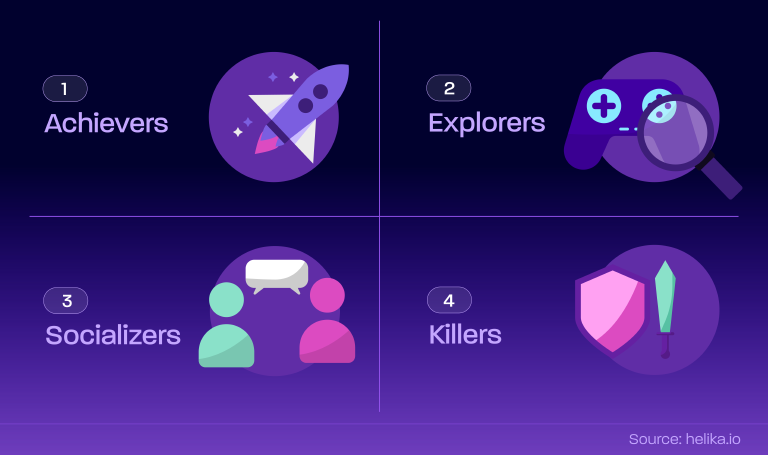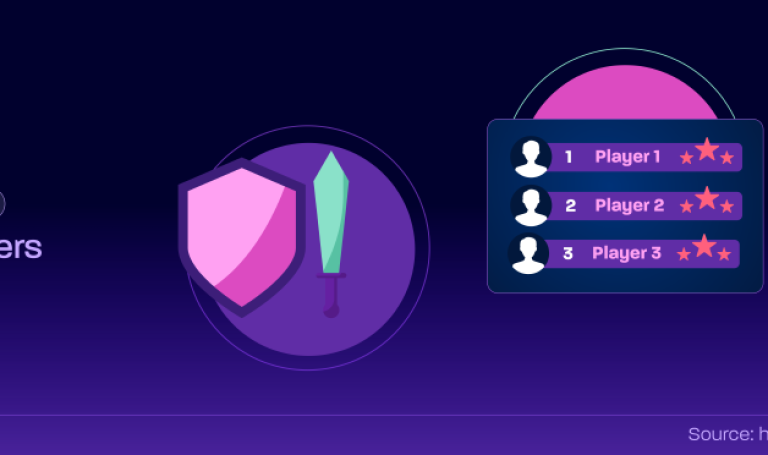Understanding your audience is essential to creating engaging and successful experiences in the context of game development. One of the most effective frameworks for this understanding is the Bartle Player Taxonomy. Developed by Richard Bartle in 1996, this model categorizes players into four distinct types based on their motivations and interactions within games.
This framework empowers developers to tailor their games to meet diverse player needs, ultimately enhancing player satisfaction and retention. In this article, we will explore the intricacies of the Bartle Player Taxonomy, its implications for game design, and how it can be utilized for game optimization and A/B testing.

The Four Player Types
Understanding the four primary player types defined by Bartle is essential for any game developer. Each type has unique motivations and behaviors that can significantly influence game design and player engagement strategies.
1. Achievers
Achievers are players who are primarily motivated by the desire to attain goals and complete challenges. They thrive on the satisfaction that comes from mastering skills and progressing through levels.

- Characteristics: Achievers often focus on leveling up, collecting rewards, and completing in-game achievements. They enjoy the sense of accomplishment that comes from overcoming obstacles and reaching milestones.
- Game Design Implications: To attract achievers, developers should create clear objectives, provide a variety of challenges, and implement robust reward systems. These can include achievements, trophies, and leaderboards that showcase their accomplishments.
2. Explorers
Explorers are driven by curiosity and a desire to discover new environments, narratives, and game mechanics. They enjoy unraveling the mysteries of the game world and often seek out hidden content.

- Characteristics: These players are less focused on completing challenges and more interested in the journey. They relish the experience of exploring every nook and cranny of the game.
- Game Design Implications: To engage explorers, developers should create expansive worlds filled with secrets, lore, and interactive elements. Providing tools for navigation and discovery can enhance the experience for these players.
3. Socializers
Socializers are motivated by interaction with other players. They thrive on building relationships, collaborating, and competing with others in the game environment.

- Characteristics: Socializers often prioritize social interactions over gameplay mechanics. They enjoy forming alliances, participating in community events, and engaging in multiplayer experiences.
- Game Design Implications: To attract socializers, developers should integrate social features such as chat systems, guilds, and cooperative gameplay modes. Creating events that encourage player interaction can also enhance their experience.
4. Killers
Killers are competitive players who derive satisfaction from defeating others. They enjoy asserting dominance and often engage in PvP (player versus player) combat.

- Characteristics: Killers thrive on competition and often seek to establish superiority. They enjoy strategies that allow them to outsmart opponents and claim victory.
- Game Design Implications: To appeal to killers, developers should incorporate competitive elements such as leaderboards, ranking systems, and PvP arenas. Balancing gameplay to ensure fair competition is also crucial.
The Importance of Understanding Player Types
Recognizing the diversity among player types is vital for effective game design. By understanding the motivations and preferences of each group, developers can create experiences that resonate with a broader audience.
Enhancing Player Engagement
Developers can enhance engagement across the board by incorporating elements that cater to different player types. A game that offers achievements for achievers, exploration opportunities for explorers, social interactions for socializers, and competitive challenges for killers is likely to attract a diverse player base.
Tailoring Game Mechanics
Game mechanics can be fine-tuned based on the dominant player types within a target audience. For example, developers can introduce more complex achievement systems and challenges if a game primarily attracts achievers. Conversely, if explorers are the focus, the game can feature vast, open-world environments with rich lore.
A/B Testing and the Bartle Player Taxonomy
Game A/B testing is a powerful tool in game optimization. It allows developers to experiment with different game elements to determine which resonates best with players. By aligning game A/B testing strategies with the Bartle Player Taxonomy, developers can gain deeper insights into player preferences.
Designing A/B Tests
When designing A/B tests, developers can create variations that cater to specific player types. For instance:
- Achiever-Focused Test: Introduce a new achievement system in one version of the game and measure player engagement and completion rates compared to the original version.
- Explorer-Focused Test: Create an alternate game environment with hidden secrets and measure how long players spend exploring versus a standard layout.
Analyzing Results
The results from A/B tests can provide valuable insights into player behavior. By analyzing metrics such as player retention, session length, and engagement rates, developers can identify which elements resonate most with different player types.

Implementing the Bartle Player Taxonomy in Game Design
Integrating the Bartle Player Taxonomy into the game design process requires a strategic approach. Here are some key steps to consider:
1. Identify Your Target Audience
Understanding who your players are is the first step. Conduct surveys, analyze player data, and gather feedback to identify the dominant player types within your audience.
2. Create Diverse Gameplay Experiences
Design gameplay experiences that cater to all four player types. This could involve incorporating various game modes, challenges, and social features to ensure every player finds something enjoyable.
3. Continuously Gather Feedback
Player preferences may evolve, so it’s crucial to gather feedback continuously. Use analytics tools to monitor player behavior and preferences, and be prepared to adapt your game accordingly.
Challenges in Utilizing the Bartle Player Taxonomy
While the Bartle Player Taxonomy offers valuable insights, implementing it in game design presents challenges.
1. Overlapping Player Types
Many players do not fit neatly into one category. For instance, a player may primarily identify as an achiever but also enjoy socializing with others. Developers must recognize these overlaps and create experiences that cater to mixed motivations.
2. Evolving Player Preferences
Player motivations can change over time and be influenced by trends, updates, and community dynamics. Developers should remain flexible and willing to adapt their designs to accommodate shifting player preferences.
Future Trends in Player Taxonomy Research
As the gaming industry continues to evolve, so will the understanding of player motivations. Future research may explore new player types or refine existing categories based on emerging trends.
1. The Rise of Casual Gaming
With casual games’ increasing popularity, understanding casual players’ motivations will become essential. Future research may identify new player types that emerge from this demographic.
2. The Influence of Technology
Advancements in technology, such as virtual and augmented reality, will likely impact player motivations. Understanding how these technologies change player interactions will be critical for future game design.
Conclusion
The Bartle Player Taxonomy is a powerful tool for game developers seeking to understand their audience. By recognizing players’ diverse motivations, developers can create engaging experiences that resonate with a broad range of individuals. Developers can optimize their games to meet player needs by carefully implementing game mechanics, gathering continuous feedback, and conducting strategic A/B testing.
As the gaming landscape evolves, staying attuned to player preferences will ensure that developers remain at the forefront of the industry. For studios looking to enhance their game development process, booking a demo with Helika can provide invaluable insights and solutions to build, grow, and optimize games. Helika is a leading gaming industry partner, offering tools and expertise to help studios navigate the complexities of player engagement and game design.
Understanding your audience is essential to creating engaging and successful experiences in the context of game development. One of the most effective frameworks for this understanding is the Bartle Player Taxonomy. Developed by Richard Bartle in 1996, this model categorizes players into four distinct types based on their motivations and interactions within games.
This framework empowers developers to tailor their games to meet diverse player needs, ultimately enhancing player satisfaction and retention. In this article, we will explore the intricacies of the Bartle Player Taxonomy, its implications for game design, and how it can be utilized for game optimization and A/B testing.
The Four Player Types
Understanding the four primary player types defined by Bartle is essential for any game developer. Each type has unique motivations and behaviors that can significantly influence game design and player engagement strategies.
1. Achievers
Achievers are players who are primarily motivated by the desire to attain goals and complete challenges. They thrive on the satisfaction that comes from mastering skills and progressing through levels.
- Characteristics: Achievers often focus on leveling up, collecting rewards, and completing in-game achievements. They enjoy the sense of accomplishment that comes from overcoming obstacles and reaching milestones.
- Game Design Implications: To attract achievers, developers should create clear objectives, provide a variety of challenges, and implement robust reward systems. These can include achievements, trophies, and leaderboards that showcase their accomplishments.
2. Explorers
Explorers are driven by curiosity and a desire to discover new environments, narratives, and game mechanics. They enjoy unraveling the mysteries of the game world and often seek out hidden content.
- Characteristics: These players are less focused on completing challenges and more interested in the journey. They relish the experience of exploring every nook and cranny of the game.
- Game Design Implications: To engage explorers, developers should create expansive worlds filled with secrets, lore, and interactive elements. Providing tools for navigation and discovery can enhance the experience for these players.
3. Socializers
Socializers are motivated by interaction with other players. They thrive on building relationships, collaborating, and competing with others in the game environment.
- Characteristics: Socializers often prioritize social interactions over gameplay mechanics. They enjoy forming alliances, participating in community events, and engaging in multiplayer experiences.
- Game Design Implications: To attract socializers, developers should integrate social features such as chat systems, guilds, and cooperative gameplay modes. Creating events that encourage player interaction can also enhance their experience.
4. Killers
Killers are competitive players who derive satisfaction from defeating others. They enjoy asserting dominance and often engage in PvP (player versus player) combat.
- Characteristics: Killers thrive on competition and often seek to establish superiority. They enjoy strategies that allow them to outsmart opponents and claim victory.
- Game Design Implications: To appeal to killers, developers should incorporate competitive elements such as leaderboards, ranking systems, and PvP arenas. Balancing gameplay to ensure fair competition is also crucial.
The Importance of Understanding Player Types
Recognizing the diversity among player types is vital for effective game design. By understanding the motivations and preferences of each group, developers can create experiences that resonate with a broader audience.
Enhancing Player Engagement
Developers can enhance engagement across the board by incorporating elements that cater to different player types. A game that offers achievements for achievers, exploration opportunities for explorers, social interactions for socializers, and competitive challenges for killers is likely to attract a diverse player base.
Tailoring Game Mechanics
Game mechanics can be fine-tuned based on the dominant player types within a target audience. For example, developers can introduce more complex achievement systems and challenges if a game primarily attracts achievers. Conversely, if explorers are the focus, the game can feature vast, open-world environments with rich lore.
A/B Testing and the Bartle Player Taxonomy
Game A/B testing is a powerful tool in game optimization. It allows developers to experiment with different game elements to determine which resonates best with players. By aligning game A/B testing strategies with the Bartle Player Taxonomy, developers can gain deeper insights into player preferences.
Designing A/B Tests
When designing A/B tests, developers can create variations that cater to specific player types. For instance:
- Achiever-Focused Test: Introduce a new achievement system in one version of the game and measure player engagement and completion rates compared to the original version.
- Explorer-Focused Test: Create an alternate game environment with hidden secrets and measure how long players spend exploring versus a standard layout.
Analyzing Results
The results from A/B tests can provide valuable insights into player behavior. By analyzing metrics such as player retention, session length, and engagement rates, developers can identify which elements resonate most with different player types.
Implementing the Bartle Player Taxonomy in Game Design
Integrating the Bartle Player Taxonomy into the game design process requires a strategic approach. Here are some key steps to consider:
1. Identify Your Target Audience
Understanding who your players are is the first step. Conduct surveys, analyze player data, and gather feedback to identify the dominant player types within your audience.
2. Create Diverse Gameplay Experiences
Design gameplay experiences that cater to all four player types. This could involve incorporating various game modes, challenges, and social features to ensure every player finds something enjoyable.
3. Continuously Gather Feedback
Player preferences may evolve, so it’s crucial to gather feedback continuously. Use analytics tools to monitor player behavior and preferences, and be prepared to adapt your game accordingly.
Challenges in Utilizing the Bartle Player Taxonomy
While the Bartle Player Taxonomy offers valuable insights, implementing it in game design presents challenges.
1. Overlapping Player Types
Many players do not fit neatly into one category. For instance, a player may primarily identify as an achiever but also enjoy socializing with others. Developers must recognize these overlaps and create experiences that cater to mixed motivations.
2. Evolving Player Preferences
Player motivations can change over time and be influenced by trends, updates, and community dynamics. Developers should remain flexible and willing to adapt their designs to accommodate shifting player preferences.
Future Trends in Player Taxonomy Research
As the gaming industry continues to evolve, so will the understanding of player motivations. Future research may explore new player types or refine existing categories based on emerging trends.
1. The Rise of Casual Gaming
With casual games’ increasing popularity, understanding casual players’ motivations will become essential. Future research may identify new player types that emerge from this demographic.
2. The Influence of Technology
Advancements in technology, such as virtual and augmented reality, will likely impact player motivations. Understanding how these technologies change player interactions will be critical for future game design.
Conclusion
The Bartle Player Taxonomy is a powerful tool for game developers seeking to understand their audience. By recognizing players’ diverse motivations, developers can create engaging experiences that resonate with a broad range of individuals. Developers can optimize their games to meet player needs by carefully implementing game mechanics, gathering continuous feedback, and conducting strategic A/B testing.
As the gaming landscape evolves, staying attuned to player preferences will ensure that developers remain at the forefront of the industry. For studios looking to enhance their game development process, booking a demo with Helika can provide invaluable insights and solutions to build, grow, and optimize games. Helika is a leading gaming industry partner, offering tools and expertise to help studios navigate the complexities of player engagement and game design.



